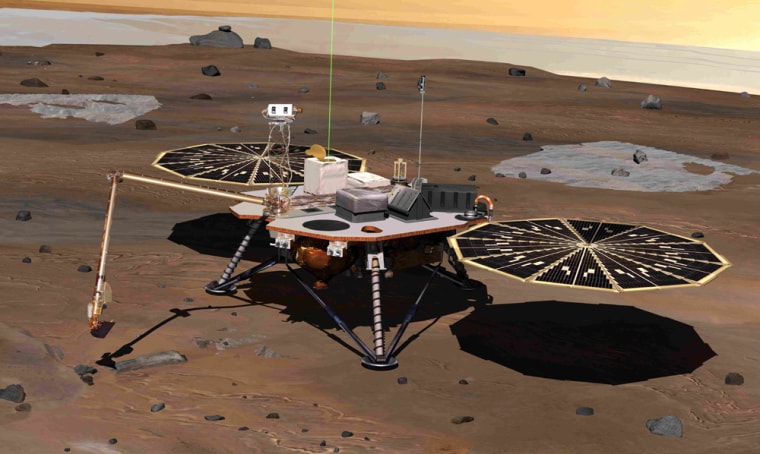Data from the now-defunct NASA Phoenix Mars Lander is shedding light on the current water cycle on Mars, particularly how water moves between the surface and the atmosphere in the northern polar region.
Phoenix's Thermal and Electrical Conductivity Probe, a forklike instrument that can be stuck in the air or the dirt, measured how water moves in and out of the surface as well as humidity in the atmosphere.
Data from the instrument shows that "the water in the atmosphere goes away every night, and at the same time, particularly later in the mission" the amount of water stuck in soil would go up at night and come back down during the day, said TECP lead scientist Aaron Zent of NASA's Ames Research Center in Moffett Field, Calif.
"These are water molecules that are interacting very strongly with the surface of the mineral grains," Zent said today at a meeting of the American Geophysical Union in San Francisco.
Changes in humidity and temperature (which can shift both with the Martian seasons and with the wobble of Mars' tilt over the course of thousands of years) alter how much water is stored in the dirt, or what scientists call regolith.
If more water is added to the atmosphere, "proportionately more of those [water molecules] end up stuck as films of water" on the grains, Zent said.
The films of water stuck between the surface and the atmosphere could be an ideal habitat for potential Martian microbes. Though there is no solid evidence for life past or present on Mars, it's such clues of habitability that the probe was sent to look for.
"There are microbes that live quite happily in that" on Earth, Zent said.
Clumpy soil
Phoenix, in part a replacement for the failed Mars Polar Lander, landed in the Vastitas Borealis plains of Mars on May 25. That arctic site provided a fresh perspective on the red planet.
In the five-plus months it spent alive at its landing site, the spacecraft dug up samples of Martian dirt and confirmed the presence of subsurface water ice. It analyzed surface samples for signs of the planet's past potential habitability.
While the bulk of the regolith that rovers and landers have encountered so far on Mars is loose, windblown dust and sand, the dirt at Phoenix's landing site was "incredibly blocky, or clotty soil," said lead scientists for Phoenix's robotic arm, Ray Arvidson of Washington University in St. Louis.
This clumpiness implies that "this material has been processed," Arvidson said, and the processing agent appears to be water.
Dwindling sunlight (caused by the transition from summer to fall at Phoenix's location, which is roughly equivalent to northern Alaska on Earth) and light-obscuring dust in the atmosphere finally pushed Phoenix below its power threshold on Nov. 2. The final cost of the mission was estimated at about $475 million, according to NASA officials.
Phoenix's observations also show that the region it landed in is a comparatively young environment on Mars.
"We're looking at current Mars whereas other missions that have landed on Mars are looking at ancient Mars," Phoenix principal investigator Peter Smith, of the University of Arizona in Tucson, said at today's briefing.
The nearby Heimdall crater was dated to about 500 million years ago — ancient by Earth standards, but fairly recent terrain for Mars.
Mysteries remain
Phoenix's wet chemistry lab showed that there "are tiny amounts of salts and larger amounts of perchlorate" in the surface layer around Phoenix, further building the case for the region's past potential habitability.
"If this were an Earth environment you would say that there are nutrients and energy sources available" for microbes to use, Smith said.
Phoenix's Thermal and Evolved-Gas Analyzer found that five percent of the landing site surface material is calcium carbonate, a mineral formed in the presence of water. However, scientists don't yet know whether the calcium carbonate formed at Phoenix's site or was blown in from elsewhere.
The lander also observed water vapor clouds, ground fogs and snow forming in the late Martian summer.
"It's a very active weather environment," Smith said. Current Mars climate models likely would not have predicted such a dynamic atmosphere, "so we're at a time now where we're going to have to reset those models" to get a more accurate idea whether the region was ever a wet environment, he said.
Throughout the coming months, Smith and his team will be further analyzing the data and working in their labs to try and recreate the signatures of minerals from Phoenix's instruments.
More on Mars Phoenix Lander |
